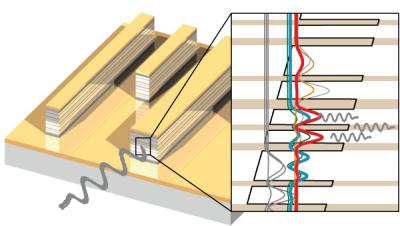Nov 15 2012
Since its invention 50 years ago, laser light has conquered our daily life. Lasers of varying wave lengths and power are used in many parts of our life, from consumer electronics to telecommunication and medicine. However, not all wave lengths have been equally well researched.
 This is a schematic picture of a quantum cascade laser. The layers of different semiconductor material constitute the bandstructure shown in the inset. (Credit: Graphics: Christoph Deutsch)
This is a schematic picture of a quantum cascade laser. The layers of different semiconductor material constitute the bandstructure shown in the inset. (Credit: Graphics: Christoph Deutsch)
For the far infrared and terahertz regime quantum cascade lasers are the most important source of coherent radiation. Light amplification in such a cascade laser is achieved through a repeated pattern of specifically designed semi-conductor layers of diverse doping through which electric current is running. "The electrons are transferred through this structure in a specific series of tunneling processes and quantum leaps, emitting coherent light particles," explains Helmut Ritsch, Institute for Theoretical Physics, University of Innsbruck in Austria, the functioning of such a laser. "Between these layers the electrons collide with other particles, which heats the laser." Thus, quantum cascade lasers only work as long as they are strongly cooled. When too much heat is produced, the laser light extinguishes.
Revolutionary concept
When looking for ways to reduce heat in lasers, PhD student Kathrin Sandner and Helmut Ritsch came up with a revolutionary idea: The theoretical physicists suggest using heat to power the laser. In their work, recently published in Physical Review Letters, the two physicists propose the theory that the heating effect in quantum cascade lasers could not only be avoided but, in fact, reversed through a cleverly-devised modification of the thickness of the semiconductor layers. "A crucial part is to spatially separate the cold and warm areas in the laser," explains Kathrin Sandner. "In such a temperature gradient driven laser, electrons are thermally excited in the warm area and then tunnel into the cooler area where photons are emitted." This produces a circuit where light particles are emitted and heat is absorbed from the system simultaneously. "Between the consecutive emissions of light particles a phonon is absorbed and the laser is cooled. When we develop this idea further, we see that the presence of phonons may be sufficient to provide the energy for laser amplification," says Kathrin Sandner. Such a laser could be powered without using electric current.
"Of course, it is quite a challenge to implement this concept in an experiment," says Helmut Ritsch. "But if we are successful, it will be a real technological innovation." The physical principle behind the idea could already be applied to existing quantum cascade lasers, where it could provide internal cooling. This simplified concept seems to be technically feasible and is already being examined by experimental physicists.
Elegant idea with technical potential
"Apart from the conceptual elegance of this idea, a completely new way may open up of using heat in microchips in a beneficial way instead of having to dissipate it by cooling," says an excited Helmut Ritsch about the work of his student. Kathrin Sandner majored in physics in Freiburg, Germany, and has worked as a researcher at the Institute for Theoretical Physics, University of Innsbruck, since 2009. "If you want to do research in quantum optics, Innsbruck is the place to go," says Sandner about her motivation to work in Innsbruck. Kathrin Sandner was supported by the DOC-fFORTE doctoral program of the Austrian Academy of Sciences and by a PhD grant from the University of Innsbruck. She is about to finish her PhD program.